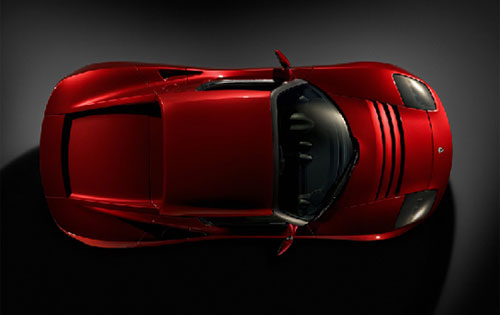Type 1 - Trials Special (1948)
 The first Lotus based on a 1930 Austin 7 saloon. Chapman ensured that every body panel was stressed such that it would add to overall strength of the car without adding unnecessary weight. This was an engineering philosophy which was to carry on for the rest of Lotus history The first Lotus based on a 1930 Austin 7 saloon. Chapman ensured that every body panel was stressed such that it would add to overall strength of the car without adding unnecessary weight. This was an engineering philosophy which was to carry on for the rest of Lotus history | |
Type 7 - Lotus Seven (1957 - 1972)
The Lotus Seven began as an uprated version of the successful Lotus Mark 6 (which was the first production sports car for Lotus). Steel tube frame with aluminium bodywork, later with glass-fibre nose and fenders. A variety of engines were used. Produced mainly in kit form, it enables many enthusiasts to own a dual-purpose road/racing sports car at a reasonable price. Four basic variants are produced by Lotus until 1973, when the rights to manufacture were taken by Caterham Cars Ltd., which still produces the Caterham Seven (a development of the Lotus Seven Series 3).
| 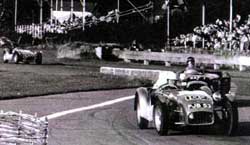 Lotus 6 and 7s at racing at Goodwood, 1958 Lotus 6 and 7s at racing at Goodwood, 1958 Modern Caterham 7 Modern Caterham 7 |
Type 10 (1955)
In 1954, Chapman brought aerodynamics to racing with Frank Costin, aeronautical aerodynamics engineer with De Havilland Aircraft Company. The Mk 8 used a MG 1467cc engine. Customer Mike Anthony wanted a Mk8 capable of running a 2 litre six cylinder Bristol engine. The Mk 10 used Dunlop disc brakes front and rear with an aerodynamic low drag body.
Type 11 (1956-1958)
The "Eleven" was a class winning car at Le Mans. It set the world speed record for an 1100cc (67 CID) car at 143mph! The Eleven won in class at the LeMans 24 hours of Endurance in the 1500cc and 1100cc classes and took the overall win for the Index of Performance. Revised in 1956 to Series 2 specifications. | |
Type 14 - Lotus Elite (1957-1962)
The Lotus Elite was introduced at the 1957 Earls Court Motor Show and was the first closed passenger offered by Lotus. It used a glass fibre monocoque chassis comprised of eight box sections. Independent front suspension by coil springs and wishbones. Independent rear suspension by Chapman struts incorporating coil springs. Powered by a 1216cc all aluminium Coventry Climax engine. Winner in class at LeMans 24 hour races. | |
Type 19 (1960 to 1962)
The Lotus revolution began with the Lotus 18 which was one of the first race cars with mid-engine design. Although under-powered when compared to the then dominant Ferraris, the Lotus 18 was capable of out handling them. In the hands of Sterling Moss, Lotus scored its first Formula One victory at the 1960 Grand Prix of Monaco.
For the road going Type 19, the Type 18 was widened and formed into Lotus' first mid-engined sports racer, powered by 2.0 and 2.5 Coventry Climax FPF engines. The 19B was built for Dan Gurney and powered by a Ford V8. The Type 19 was also known as the Lotus Monte Carlo. | |
Type 23 (1962 to 1964)
One of the most popular sports racers in Lotus history. Powered by the Ford based engines, 1100cc and later the Lotus Twin Cam. Used Type 19 suspension, with larger tanks.
The Type 23 was one of the cars used for styling inspiration for the Lotus Elise. | |
Type 26 - Lotus Elan (1962 - 1973)
The first Lotus road car to use the now famous steel backbone chassis over which a glass-fibre body was fitted. First available as a roadster, an optional hardtop was later offered, and eventually a coupe version. The Elan continued in production through to 1974 and became the most produced Lotus ever. | |
Type 28 - Lotus Cortina (1963 - 1966)
Ford of England came to Lotus to build 1000 special Cortina GT's with a twin cam engine to compete in Group 2. The Lotus Cortina sported a completely different rear suspension, light alloy body panels and Lotus Twin Cam engine. Top speed was 105 mph, 0-60 in 9.9 sec. The Lotus Cortina dominated the Sedan classes in its time. Click here for a Lotus Cortina restoration site; or here for more Lotus Cortina Mark 1 info. | |
Type 38 - Indianapolis Racer (1965)
The Lotus Type 38 represented a major structural improvement over its predecessors, the 1963 Type 29 and the 1964 Type 34. The Type 38 was of true monocoque, stressed skin construction, rather than being merely a "bathtub" with non-stressed upper bodywork. Lotus estimated that it had 50% greater torsional stiffness. The off-set suspension and DOHC 4.2 litre 505bhp V-8 engine followed previous Lotus practice.
This car, driven by Jim Clark, won the Indianapolis 500 in 1965, and finished 2nd in 1966 behind Graham Hill in a Lola. | |
Type 40 (1965)
Only 3 Type 40's were built. The bodywork was distinctive with two angled stack exhausts emerging from the rear deck. The last Lotus sports racer to be built. Powered by a Ford 5.3 litre V8, 410 bhp.
More Type 40 info here: http://www.pistonheads.com/lotus/type40/ | |
Type 43 (1966 - 1967)
Chapman truncated the monocoque chassis, ending it abruptly behind the driver. The engine was mounted to the rear bulkhead and the entire rear suspension was mounted to the engine and transaxle. Other teams declared that the car would fold in half at the first corner. Today EVERY Formula One, Indy Car and World Endurance Cup car has a truncated monocoque chassis with its engine and transaxle carrying the rear suspension, it is now accepted as the "only" way to build a fast race car. Formula One History | |
Type 46 - Lotus Europa (1967 - 1974)
The first non-track mid-priced mid-engined car produced. A glass fibre body draped over a steel backbone chassis with 4 wheel independent suspension. Early cars were powered by a Lotus modified Renault engine. Later this engine was replaced by the Lotus Twin Cam engine and a 5 speed gearbox. | |
Type 49 (1967 to 1970 )
The Lotus 49 was an uprated Lotus 43 designed for Formula 1 using a truncated monocoque chassis. In its inaugural race it not only took pole position in the hands of Graham Hill but was victorious in the hands of Jim Clark. This car introduced the Ford Cosworth DFV V8 engine to racing. Later derivatives of the Lotus 49 introduced aerofoils, high mounted wings, wedge shaped body panels, and the use of air management to create downforce. The Lotus 49 took Lotus to the Constructor's Championship in 1968. Click here for more Lotus 49 info, or here for even more. | |
Moonraker, 1971
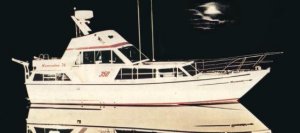 Colin Chapman took over the Moonraker Marine boatyard in 1971 and redesigned their product, the Moonraker 36. The boat had a glass fibre hull and Chapman was to later introduce a revolutionary technique producing one piece vacuum injection moulded GRP hulls in an ex-war aircraft hangar on the edge of Hethel airfield, next to the Lotus Cars factory in Hethel. The method was eventually used for the production of the Lotus cars . Colin Chapman took over the Moonraker Marine boatyard in 1971 and redesigned their product, the Moonraker 36. The boat had a glass fibre hull and Chapman was to later introduce a revolutionary technique producing one piece vacuum injection moulded GRP hulls in an ex-war aircraft hangar on the edge of Hethel airfield, next to the Lotus Cars factory in Hethel. The method was eventually used for the production of the Lotus cars .
 Clan Crusader, 1971 Clan Crusader, 1971
The Clan Crusader is a fibreglass monocoque sports two-seater, powered by a Rootes Imp Sport engine. Paul Haussauer and John Frayling designed this car as a follow-up to the Europa, but when Chapman didn't accept their plans they started their own business, aided by government development grants in Washington near Durham. Approximately 350 cars were built by Clan Motor Company, some at the beginning being sold as kit cars. More info here and the owners club website |
Type 50 - Lotus Elan Plus Two (1967 - 1973)
Lotus enlarged the backbone chassis of the Elan and kept the Twin Cam engine, the disc brakes, the independent suspension; but was able to offer two jump seats and a roomier cabin. This was Lotus' first "family" car. The Elan Plus 2 retained all of the sporty performance of the standard Elan but, added practicality. | |
Type 72 (1970 to 1975)
The most successful Formula One race car ever raced. The Lotus 72 used variable rate torsion bar springs at both front and rear, front inboard disc brakes, the continuation of the wedge aerodynamic bodywork, multiple element rear wing and side radiators. Today nearly every formula car uses these elements introduced by the Lotus 72. The Lotus 72 won 3 World's Constructor's Championships and 2 Driver's Championships and is the only Formula One race car to have won 20 Grand Prix races. Click here for more Lotus 72 info. | |
Type 75 - Lotus Elite (1974 - 1982)
The new Elite was a four place car with a glass-fibre body and a steel backbone chassis. 4 wheel independent suspension system. Power was provided by Lotus' own 907 twin cam 4 valve per cylinder all aluminium engine. This engine was the first 4 valve production engine sold on the open market. | |
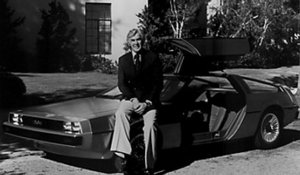 DeLorean DMC12, 1981 DeLorean DMC12, 1981
In 1981, Chapman became involved in a new venture with his friend John DeLorean. The DeLorean sports car is now best remembered for its role in the Back to the Future films, but prior to this the name DeLorean was best known for scandal. The British government gave DeLorean tens of millions of pounds to put his sports car into production in an unemployment blackspot in Belfast, at an axis between Catholic and Protestant communities. De Lorean used some of the money to pay Chapman to design the car (based on the Lotus Esprit), and further money was extracted from the government using a network of offshore companies. The car once produced was underpowered, overpriced, and extremely poor quality - DeLorean declared insolvency in January 1982. DeLorean's arrest on coke-dealing charges simply added to the chaos (he successfully defended those charges). In February, the British government appointed receivers and by October production had ceased, after only 8,550 cars had been built. DeLorean evaded extradition and was never jailed for his part in the operation. Colin Chapman died of a heart attack in 1982. Lotus MD Fred Bushell was left to serve a three year sentence. The frustrated trial judge commented that if Chapman and De Lorean had been there they would have each received 10 year sentences for "an outrageous and massive fraud". |
Type 76 - Lotus Eclat (1975 - 1982)
The Lotus Eclat was a fastback version of the new Elite. The rear roof line of the Elite was sloped down into a sporty fastback. Replacing the glassback of the Elite was a trunk lid that opened to a generously sized and practical boot.
This type designation was also assigned to an F1 car. It featured twin brake pedals (for left foot braking), with an electronically activated clutch controlled by a button atop the gear selector. | |
Type 78 (1974)
The JPS Mk1, designed as a replacement for the Type 72. Click here for more Team Lotus info. | |
Type 79 - Lotus Esprit (1976 - 1980)
The Lotus Esprit was first shown to the world as a styling exercise by the famous Italian design studio of Giugiaro Design in 1974. The show car was so successful, and inquiries so great, that Lotus committed to taking the successor to the Europa into production. Glass-Fibre bodied, steel backbone chassis and Lotus' own 907 multi-valve engine mounted mid-ship with 4 wheel independent suspension were all features of these first Esprits. | |
James Bond Submarine Esprit, 1977
The Lotus Esprit was perhaps the most advanced car Bond has driven, it had the capability to transform into a submarine, and an array of other ingenious gadgets. The Lotus was personally delivered to 007 in Corsica in the film The Spy Who Loved Me, driven by Q, who warned Bond to be careful with the car. Bond responded to Q with a smart remark, dropped the clutch, and took off with a grinding screech. | |
Type 79 (1978 to 1979)
The Lotus 79 refined the concept of Ground Effects (a concept first developed by Lotus in their Type 78) to its fullest extension. It dominated the season scoring 8 Grand Prix wins out of the 16 races. Lotus became the 1st team in Formula 1 history to score 3 consecutive 1-2 victories. Lotus again won the Constructor's and Driver's Championships. Every race car today uses the Ground Effects system of under car air management. Click here for more Lotus 79 info. | |
Type 81 - Sunbeam Lotus Talbot (1980)
A derivative of the Lotus 907 engine was dropped into a Chrysler (Omni) Sunbeam chassis and became an instant Rally winner. Click here for the UK Avenger and Sunbeam Owners Club.
This type designation was also used for an F1 car. | |
Type 82 - Lotus Turbo Esprit (1981 - 1987)
Lotus used the turbocharging technology learned in racing and applied it to the Esprit. Instantly power output was raised to 210 bhp from 2.2 litres. The Turbo Esprit received revised rear suspension and a revised and stronger chassis. A deeper front spoiler and taller spoiler were added to cope with the higher speeds. The Turbo Esprit was capable of 0-60 mph in 6 seconds and 150 mph. Power was raised to 215 bhp in 1986 with Bosch K-Jetronic fuel injection. | |
Excel (1982 - 1992)
Around 1982/83 when the Excel was introduced, the Eclat Excel also existed. Lotus put forward the Excel as an improved Eclat to avoid Type Approval. Lotus even roled over the name and the first Excels were badged Eclat on the boot, Excel on the rear wings, but after a short while the Eclat badge was dropped and by late 1983 the Excel was fully established.
http://www.mikecauser.com/
http://www.lotusexcel.co.uk/ | |
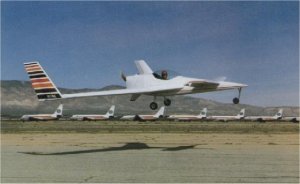 Ultralight, 1982 Ultralight, 1982
Colin Chapman loved to fly and had a vision of designing and making an aeroplane for the individual. He dabbled in designing a personal jet in the 1970's, but turned to ultralights as they were less regulated. Very simple winged hang gliders with a small engine and propeller, he was aiming for 2-seat aeroplanes that could be used for both business and pleasure. Designer Burt Rutan was contracted to design and build a prototype 2-seater ultralight for him whilst Lotus developed a light and small engine. This project was never finished before Colin Chapmans death. |
Type 90 (1981)
The proposed new Elan project, using Toyota running gear. Became project X100 when Toyota running gear was dropped. |
Type 98T
This is the Lotus 98T, as raced in the 1986 F1 season by Ayrton Senna and Jason Dumfries. It was powered by the Renault 1.5 litre V6 Turbo engine. Senna drove it to two GP victories and had eight other point finishes. Lotus took third in the Constructors' points table. | 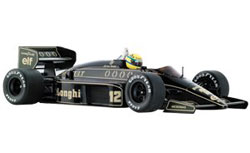 |
Type 99T (1987)
Unveiled in London on 3rd February 1987 the Lotus 99T holds the honour of being the last ever Lotus Formula One car to win a Grand Prix.
Sportung bright yellow and blue of the sponsors Camel. Moving away from the Renault powerplants that had been employed since the Type 93T in 1983, the 99T harnessed a new twin-turbo Honda unit capable of pushing out more than 800bhp. This car also reintroduced the revolutionary ‘Active' suspension system. Active suspension was eventually outlawed as it gave massive performance and handling advantages. | 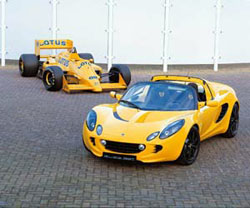 |
Lotus Esprit Turbo (1988 - 1989)
In 1988 the Esprit gave up its original lines of Giugiaro and received a complete makeover. The new lines were curved and softer. The interior was also greatly revised. The electrical system was completely replaced with new wiring, gauges, switches and central electric door locks. In 1989 the Esprit Turbo engine received a complete electronic engine management system based on Delco components. This further boosted output to 228 bhp and 0-60 times were reduced to 5.2 seconds and top speed rose to 155 mph. A stronger Renault built 5 speed transmission was also fitted to handle the increased power. |
|
Type 100 - Lotus Elan (1990)
Powered by a 1588cc twin cam 16 valve turbocharged engine that produces 162 bhp, the Elan goes from 0 to 60 in 6.7 seconds and attains a top speed of 137 mph. The chassis is a hybrid of Lotus' classic steel backbone mated with advanced composites to create one the stiffest cars in the world. | |
Type 104 - Lotus Carlton/Omega (1990)
Lotus developed and built version of the Vauxhall Omega and Opel Omega 4 door sedan with a 3.6 lire 24 valve twin turbo straight six. A 6 speed gearbox from the Lotus developed Corvette ZR-1 allows the Lotus Carlton/Omega to hit 170 mph and 0-60 in under 6 seconds. Click here for James Waddington's Lotus Carlton site. | |
 Lotus Emotion Lotus Emotion
In 1991 Bertone decided to design a new body for the chassis of the Lotus Esprit, produced by General Motors. The chassis is the same length as the Lotus Esprit (245 cm), but with the total length at just over 4 metres (406 cm) this really is a very compact car. Link to Bertone here |
Lotus Esprit Turbo SE (1989-1993)
The Esprit Turbo SE is a further development of what is a very capable vehicle. The power of the Esprit Turbo SE is raised to 280 bhp with the use of a Lotus developed Chargecooler and and enhanced Engine Management System that uses six fuel injectors. Outwardly the Esprit Turbo SE sports a deeper front air dam and a rear wing. 0-60 times have fallen into the mid 4 second range and top speed is in excess of 165 mph. In 1991 three variations of this car were produced, the standard Turbo SE, the Jim Clark Special, and the X180R (the street version of the race car). | |
Type 108 prototype Olympic bicycle
Gold Medal Barcelona (1992)
Lotus developed the aerodynamically optimised carbonfibre Lotus Sport bicycle, on which Chris Boardman rode to a gold medal in the 4000 metre pursuit at the Barcelona Olympic Games in July 1992. Type 110 was the production version of type 108 bicycle. | |
Type 109 - F1 car, 1994
Mugen/Honda ZA5C engined F1 car.
See here for the full tech spec. | |
Type 110 - Road Bike
The road racing version of the carbon bike (brakes and gears, twin rear blades), as ridden by Boardman et al in the Tour de France | |
Scorpion Tank
 The army recruited Lotus in 1994 to develop active suspension and active track tensioning for the Scorpion tank; by keeping the Scorpion's body steady while on the move, they improved its speed over rough terrain and created a more stable gun platform. Boats, trucks, buses and even microlights appear in their portfolio of projects. The army recruited Lotus in 1994 to develop active suspension and active track tensioning for the Scorpion tank; by keeping the Scorpion's body steady while on the move, they improved its speed over rough terrain and created a more stable gun platform. Boats, trucks, buses and even microlights appear in their portfolio of projects. |
Lotus Esprit S4 & S4s (1994-1995)
The S4 represented a significant milestone for the Esprit model. Exterior changes included new front and rear bumpers and valances, new sidepods, a mid-mounted rear wing, and 17" wheels. Inside, a larger passenger cabin, the addition of a passenger airbag, and power assisted steering helped to elevate the Esprit to new levels of refinement. Joining the S4 for 1995 was the S4s, which was visually distinguished by an aggressive rear wing providing additional downforce. A larger turbocharger provided up to 300 bhp and was complimented by a firmer suspension with uprated springs and dampers. Top speed of 165 mph and a 0-60 mph time of 4.6 seconds. | |
 Type 112 (1995) Type 112 (1995)
A stillborn F1 car intended for the 95 season. Sadly it never progressed beyond the drawing board as a result of Teams demise.
112 was originally allocated to the car which became the Elise, but the number was swapped for 111 (which had already been allocated to the 95 F1 car) because at one early stage the intention was to call the Elise "one-eleven" in honour of the original Lotus Eleven from the fifties. |
Type 111 - Lotus Elise (1996)
Conceived as a low production model, the Elise has shattered sales expectations and returned Lotus to the forefront of sports car production. This incredible car has also spawned some very interesting limited editions, including the 340R, the Exige coupe, and several motorsport derivatives.
The major (IMO) derivatives of the Elise are summarised below, for a more complete list of variations on the Elise, click here | |
Type 113
Number not allocated! Type 114 - Le Mans / GT2 Esprit (1996)
The Type 114 debuted at the BPR Karcher Global Endurance GT series four hour race at Donnington., an improved version was later unveiled at the Paul Richard circuit for the first race of 1996 GT series. It had a Lotus V8 engine, a six-speed racing transmission, F1-style aerodynamics, carbon brakes, and is down to the 900 kg minimum weight limit. After showing initial promise, it retired due to fractured exhaust. More info here |
Lotus Esprit V8 (1997)
After more than 20 years, the Esprit's venerable 4 cylinder engine was replaced with a compact yet powerful 3.5 litre twin turbo V8. This very special car is the quickest and fastest of all road going Lotus. Capable of attaining 60 mph in just over 4 seconds with a top speed of 180 mph places this Esprit firmly in supercar territory. A revised suspension benefits from 17" front and 18" rear wheels mounting Michelin or Dunlop Z rated high performance tires. The latest V8 includes AP Racing Brakes with cross-drilled discs, OZ Racing wheels, and a tailgate-mounted rear wing. Available options include a removable glass roof panel. | |
Lotus Emme (1997)
While mainly specialising in scooters, the Brazilian company Emme joined Lotus in 1997 to produce a sedan based on the existing Emme 420 and 420T. The turbocharged 16-valve engine produced over 121 hp per litre and 354 Newton metres of torque, achieving 0-60 mph in 4.9 sec, 0-100 mph in 11.9 sec, and with a top speed 171mph. Only 12-15 were ever built. | |
Type 115 - Lotus Elise GT1 (1997)
In 1997 Lotus unveiled the Lotus Elise GT1, a derivative of the Lotus Elise and powered by a 3.5 litre eight-cylinder engine with 580bhp. The body is carbon-fibre. Performance is 0-60 in 3.8 seconds, and top speed is 200 mph.
For more info click here | |
340R (August 1999)
Outrageously styled and dynamically outstanding, the 340R is powered by a 1.8-litre VHPD (Very High Performance Derivative) K series engine producing 180PS. And in an extremely light car, equipped with a close ratio gearbox, that adds up to explosive performance of 0-60mph in 4.4secs, for instance, and a top speed of 133mph (214km/h). | |
Exige (April 2000)
The Exige is a road-going replica of the Sport Elise racer, albeit with a few concessions to type approval regulations and the rigours of everyday road use.
More info here | |
Type 116 - Opel Speedster / Vauxhall VX220 (2000)
Nicknamed the Skipton in Hethel during development, Lotus has worked in co-operation with designers and engineers from the Opel/Vauxhall International Technical Development Centre in Ruesselsheim, Germany, to build the VX200 (named the Speedster for the European market). Lotus built the original concept show car - one of the stars of the March 1999 Geneva Motorshow. For more info, click here | |
Lotus Extreme concept car (2000)
The proposed vehicle is a radical, two-seater, with a fighter-cockpit seating arrangement, bringing together influences from aerospace, motorcycle and powerboat vehicles. Its construction will comprise of an aluminium chassis with composite bodywork and carbon fibre aerodynamic finning. The driving experience will be maximised by a unique suspension system, which will allow the vehicle to lean into bends. The total weight of the vehicle would be in the region of only 450kg, and the concept specification estimates a top speed of 150mph and a 0-60mph time of around 5 seconds. More info here, more pictures here | |
Lotus Shopping Trolley (2000)
"The fundamental techniques of vehicle engineering apply to both sportscars and to all other vehicles including the humble shopping trolley. The requirements for a fine handling sportscar are both stability and agility in the driving experience. This can be a conflict but with clever, intelligent design you can find a perfect and balance between sporty handling and confidence inspiring stability." More info here | |
Type 117 - Lotus Elise Mark II (2001)
(This car is identified as a 111 variant for type approval). The Elise updated. The smooth contours have faded in favour of a more aggressive angular image. Available with two options - the Sports Tourer or the Race Tech. Nicknamed the Monza in Hethel during development.
More info here, and some pre-production model pictures here (along with the M250) | |
 Electric Lotus Elise, manufactured by Zytek Electric Vehicles Limited. The Zytek electric Lotus Elise is powered by two oil-cooled, internally mounted brushless DC, Zytek electric motors. Power is transmitted through custom Zytek gearboxes and standard Lotus drive shafts, each motor weighing only 13 kg but producing up to 75kW (100bhp) and 550 Nm torque. The car has a driving Range of about 120 miles (urban driving), and a top speed of 90 mph. Acceleration is 0-90 mph in 11.2 sec, and the car weighs 875 kg (with battery pack). Other features include trailing throttle and pedal activated regenerative braking. Electric Lotus Elise, manufactured by Zytek Electric Vehicles Limited. The Zytek electric Lotus Elise is powered by two oil-cooled, internally mounted brushless DC, Zytek electric motors. Power is transmitted through custom Zytek gearboxes and standard Lotus drive shafts, each motor weighing only 13 kg but producing up to 75kW (100bhp) and 550 Nm torque. The car has a driving Range of about 120 miles (urban driving), and a top speed of 90 mph. Acceleration is 0-90 mph in 11.2 sec, and the car weighs 875 kg (with battery pack). Other features include trailing throttle and pedal activated regenerative braking. |
 M250 (Type 118?) M250 (Type 118?)
Frankfurt Motorshow 1999 - Powered by a mid-mounted Lotus-tuned 3.0 litre V6 engine that drives the rear wheels through a six-speed gearbox, project M250 was aimed to slot into the Lotus line-up between the Elise and the Esprit. Click here for a preview of the M250. More info from Pistonheads.
Unfortunately this programme was cancelled :-( |
Lotus Lada (2002)
 A 1996 Lada given a £100,000 makeover by Lotus cars of Norfolk, all courtesy of the BBC TV series Top Gear. Modifications made were sports lowered and much stiffened suspension, bilstein dampers, sports brakes, unique paint and decals, specially trimmed OMP racing seats with interior specially tailored to match, Momo steering wheel, big fat BBS alloy wheels with Yokohama track tyres. The engine is a Fiat 2 litre twin cam engine that has been stage 2 race tuned by renowned race engineer Guy Croft, and coupled to a fiat 131 five speed box via a race clutch. it develops approximately 180bhp at 5,000 RPM, is capable of 0-60 in about 7 seconds and has a top speed of 135mph. More info here: http://www.guy-croft.com/page11.html A 1996 Lada given a £100,000 makeover by Lotus cars of Norfolk, all courtesy of the BBC TV series Top Gear. Modifications made were sports lowered and much stiffened suspension, bilstein dampers, sports brakes, unique paint and decals, specially trimmed OMP racing seats with interior specially tailored to match, Momo steering wheel, big fat BBS alloy wheels with Yokohama track tyres. The engine is a Fiat 2 litre twin cam engine that has been stage 2 race tuned by renowned race engineer Guy Croft, and coupled to a fiat 131 five speed box via a race clutch. it develops approximately 180bhp at 5,000 RPM, is capable of 0-60 in about 7 seconds and has a top speed of 135mph. More info here: http://www.guy-croft.com/page11.html |
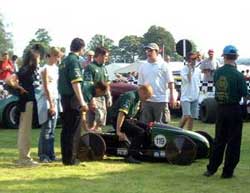 Type 119 Lotus soapbox (July 2002) Type 119 Lotus soapbox (July 2002)
The world’s fastest go-kart, capable of reaching 60mph in 4.3 seconds, and has a top speed of 207mph. The Lotus Type 119 weighs just 77lb, has a carbon fibre monocoque and utilises bonded aluminium in its construction. The engineless kart is designed to race on downhill courses where gravity will power it.
It competed for the first time at The Goodwood Festival Of Speed in the '2002 Goodwood Gravity Racing Soapbox Challenge' - where it was expected to reach a speed of around 60mph. More info here (Picture © MarkS)
M120 - Elise Coupe (1998) & M121 - Europa S (2005)
Project M120 was suspended in 1998. To answer the obvious question - the addition of a roof meant that the whole car was stiffer, which meant that lower sills could be used to accommodate larger doors - making entry and exit easier.
More powerful engines were also considered - including the Rover 2.5 KV6 and even (reportedly) the 1.6 V8 twin turbo used in the Suzuki concept car (250bhp). The Elise Coupe (codenamed Sepang) eventually emerged in Dec 2005 as the Lotus Europa, click here for more details. 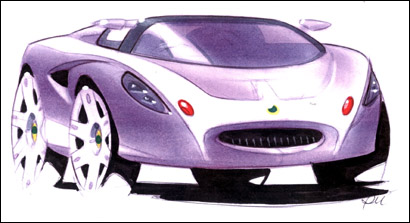 Lotus ECO2S, 2002 Lotus ECO2S, 2002
The 2002 Geneva motor saw the launch of Lotus Engineering's project: 'ECO2s' (pronounced ECOS). The project uses a number of new techniques to reduce emissions and body weight with the ultimate goal of an environmentally friendly sports car.
More info here
Federalised Elise, January 2003 (Elise 111R)
In January 2003 the first official announcement about a US bound Elise was made, to be based on the European Elise but with additional safety equipment to satisfy US legalities. At the same time as this announcement, it was also declared that the the Lotus Esprit would reach the end of its long and illustrious life in early 2004 in the USA and mid 2003 in Europe - with an all new replacement to be announced at a future date.
In September 2003 Lotus announced that the Toyota 2ZZ-GE 1.8 litre 4 cylinder 16-valve engine with Variable Valve Timing and Lift-Intelligent (VVTL-i) system had been chosen, to be mated to a six-speed gearbox and tuned by Lotus specifically for the U.S. and to produce around 190hp. The Federalised Elise was officially launched at the 2004 Los Angeles Auto Show where the weight was confirmed at 891kg, 0-60mph claimed at 4.8 seconds and top speed at 150mph. The additional weight is down to twin airbags, brake servo and TRW anti-lock brakes, climate control, air-conditioning, carpets and additional sound proofing and a larger fuel tank. It also has a starter button.
It was planned to get some in-life experience of the engine and to reduce potential launch issues and associated legal problems in the US by offering the same engine in the new Exige S2, due to be launched at the Geneva motorshow in 2004. The Toyota Elise was also made available in the UK under the name 111R in January 2004
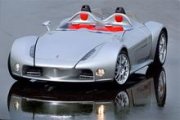  | The Pininfarina Enjoy,
Sept 2003
Concept car by Pininfarina called the Enjoy. This car converts from a road car with fenders to a open wheeled, race car. More details here |
 Motorsport Exige, Jan 2005 Motorsport Exige, Jan 2005
A direct motorsport derivative of the successful Lotus Exige. This Lotus designed and engineered racecar was part manufactured by RTN, the team responsible for the Le Mans winning Bentley, using the latest motorsport techniques and procedures to produce a lightweight yet strong carbonfibre bodywork structure.
More details here
Lotus Sport Exige 240R, 25th Feb 2005
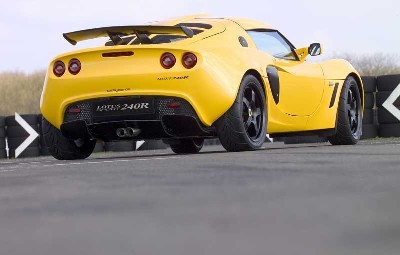 Lotus Sport, the performance division of Lotus Cars Ltd., developed the Lotus Sport Exige 240R, a limited edition of 50 cars. With a supercharged and intercooled engine producing over 240 hp and over 170 lbft of torque, 0- 60mph in less than 4s and 100mph (160 km/h) in less than 10s before topping out at 155 mph (249 km/h). At this top speed the aerodynamics produce 113 kg of downforce increasing grip, stability and safety. More details here and here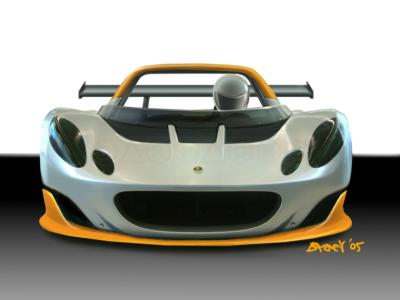 Lotus Circuit Car, June 2005 Lotus Circuit Car, June 2005Tony Shute, Head of Product Development at Lotus Cars: "The new product has allowed Lotus to once again apply its key "performance through lightweight" philosophy. This is in order to achieve an innovative product for the track day and club racing Lotus enthusiast whilst staying true to the key design attributes of the Elise and Exige products." Project delayed whilst Lotus focused on the Europa. More here.
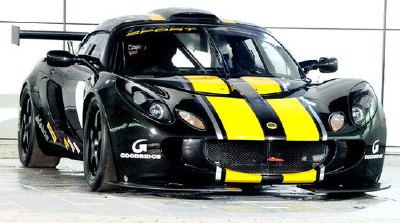 A prototype of the Lotus Sport Exige race car was unveiled at the annual FIA GT Championship presentation ceremony outside the world famous Casino in Monte Carlo, Monaco on 02 December, 2005. This car was designed for the FIA series to start in 2006 for race cars that have an equal power to weight, and that have a direct lineage to their road going versions. In its maiden year (2006), Lotus Cadena ran in the Avon Tyres British GT Championship. More here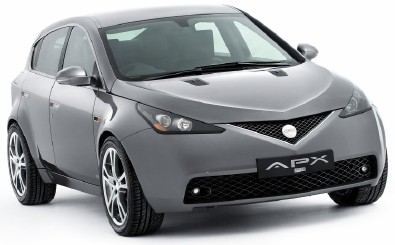 APX, VVA technology, Feb 2006 APX, VVA technology, Feb 2006
Displayed at Geneva, the Aluminium Performance Crossover (APX) concept - a showcase of Lotus Engineering’s aluminium Versatile Vehicle Architecture (VVA). The design concept is expected to be used for the new Esprit replacement, but Lotus is also hoping to sell the concept to third parties. More details here
Exige 265E, Aug 2006
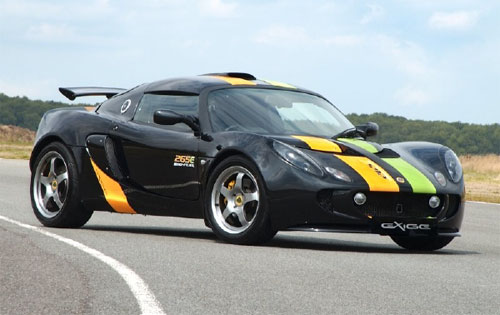 Lotus Cars has introduced the Exige 265E, which it describes as the most powerful road version of the car ever. The E suffix indicates that the Exige has been adapted to run on bio-ethanol. Lotus fitted a slightly modified version of the 2ZZ VVTL-i supercharged four-cylinder that powers the production Exige S. Running on E85, the car delivers 265 horsepower and sprints from zero to 60 mph in 3.9 seconds, with a top speed of 158 mph.
 GT3 Exige, 2007 GT3 Exige, 2007
Lotus Sport, the race car performance arm of Lotus Cars Ltd, unveiled the Lotus Exige GT3 concept road vehicle at the 77th annual Geneva International Motor Show. More details here
Tesla, 2006
Silicon Valley startup firm Tesla Motors developed a pure-electric, high-performance two-seater called simply the Roadster. The carbon-fiber-bodied Tesla Roadster was originally designed by and jointly developed with Lotus. |
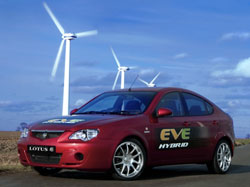 EVE HYBRID, March 2007 EVE HYBRID, March 2007
The EVE programme was undertaken by a cross-functional team of Lotus and Proton engineers working together at Hethel and Shah Alam, Kuala Lumpur. The resulting EVE Hybrid demonstrator, based on a Proton Gen.2 compact midsize car with a 1.6litre gasoline engine, but with tailpipe emissions down by 22% and fuel economy improved by 28%. See here for more details 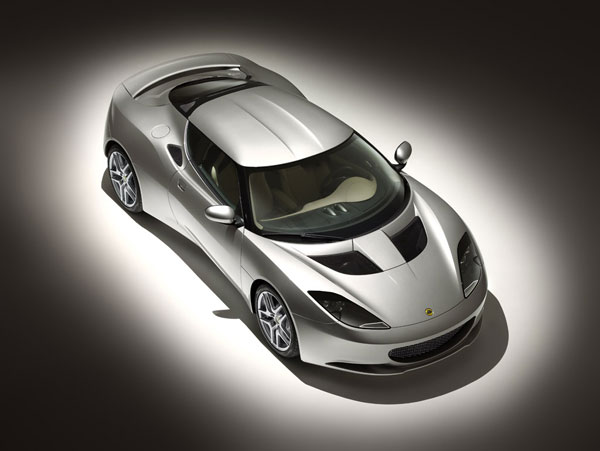 Evora, July 2008 Evora, July 2008 (Type 124)
Announced to the 2009 Frankfurt Motorshow, the Evora Type 124 to be homologated for either FIA or GT3-spec racing, but until the technical regulations for those series are finalised - and until Lotus knows exactly how quick the Evora Type 124 is - the two factory-supported cars will run broadly to VLN Nurburgring endurance championship regs.
Source: Lotus |
















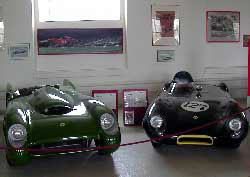
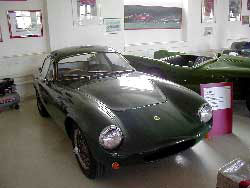
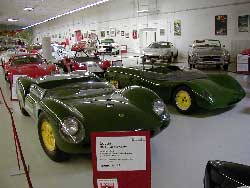
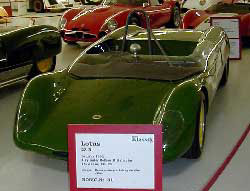
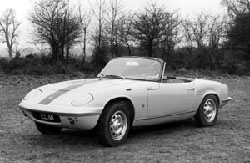
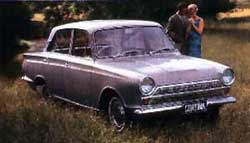


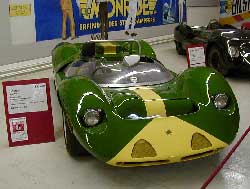
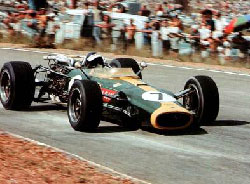
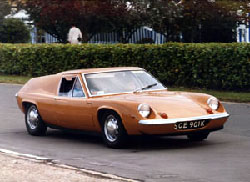
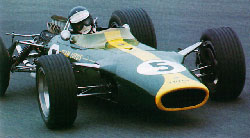
 Colin Chapman took over the Moonraker Marine boatyard in 1971 and redesigned their product, the Moonraker 36. The boat had a glass fibre hull and Chapman was to later introduce a revolutionary technique producing one piece vacuum injection moulded GRP hulls in an ex-war aircraft hangar on the edge of Hethel airfield, next to the Lotus Cars factory in Hethel. The method was eventually used for the production of the Lotus cars .
Colin Chapman took over the Moonraker Marine boatyard in 1971 and redesigned their product, the Moonraker 36. The boat had a glass fibre hull and Chapman was to later introduce a revolutionary technique producing one piece vacuum injection moulded GRP hulls in an ex-war aircraft hangar on the edge of Hethel airfield, next to the Lotus Cars factory in Hethel. The method was eventually used for the production of the Lotus cars .

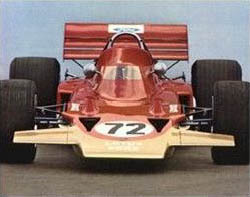
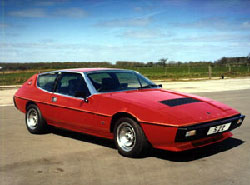

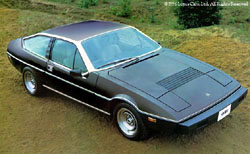

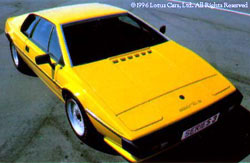
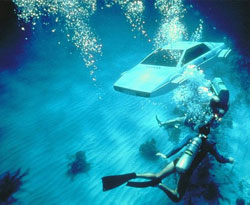
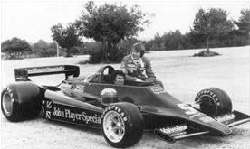
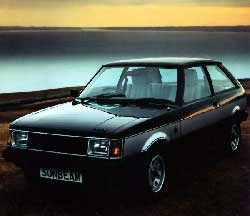

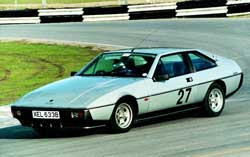



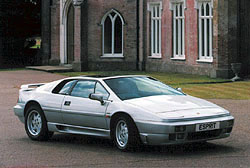

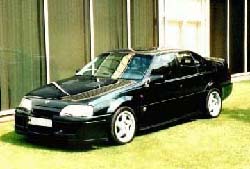

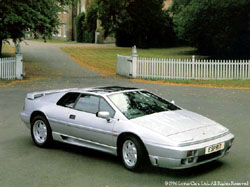
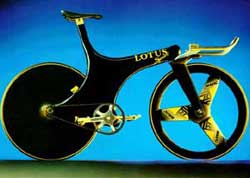


 The army recruited Lotus in 1994 to develop active suspension and active track tensioning for the Scorpion tank; by keeping the Scorpion's body steady while on the move, they improved its speed over rough terrain and created a more stable gun platform. Boats, trucks, buses and even microlights appear in their portfolio of projects.
The army recruited Lotus in 1994 to develop active suspension and active track tensioning for the Scorpion tank; by keeping the Scorpion's body steady while on the move, they improved its speed over rough terrain and created a more stable gun platform. Boats, trucks, buses and even microlights appear in their portfolio of projects. 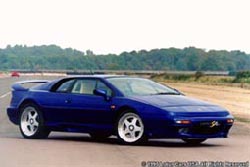

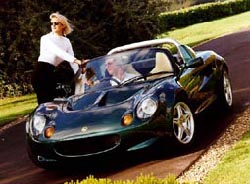
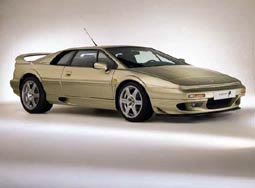



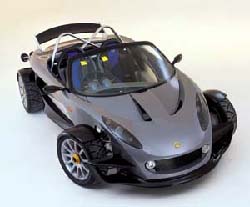
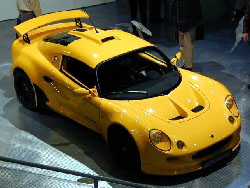
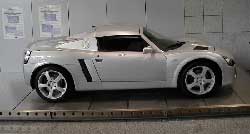


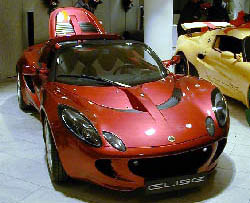


 A 1996 Lada given a £100,000 makeover by Lotus cars of Norfolk, all courtesy of the BBC TV series Top Gear. Modifications made were sports lowered and much stiffened suspension, bilstein dampers, sports brakes, unique paint and decals, specially trimmed OMP racing seats with interior specially tailored to match, Momo steering wheel, big fat BBS alloy wheels with Yokohama track tyres. The engine is a Fiat 2 litre twin cam engine that has been stage 2 race tuned by renowned race engineer Guy Croft, and coupled to a fiat 131 five speed box via a race clutch. it develops approximately 180bhp at 5,000 RPM, is capable of 0-60 in about 7 seconds and has a top speed of 135mph. More info here:
A 1996 Lada given a £100,000 makeover by Lotus cars of Norfolk, all courtesy of the BBC TV series Top Gear. Modifications made were sports lowered and much stiffened suspension, bilstein dampers, sports brakes, unique paint and decals, specially trimmed OMP racing seats with interior specially tailored to match, Momo steering wheel, big fat BBS alloy wheels with Yokohama track tyres. The engine is a Fiat 2 litre twin cam engine that has been stage 2 race tuned by renowned race engineer Guy Croft, and coupled to a fiat 131 five speed box via a race clutch. it develops approximately 180bhp at 5,000 RPM, is capable of 0-60 in about 7 seconds and has a top speed of 135mph. More info here: 
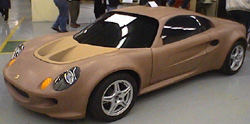
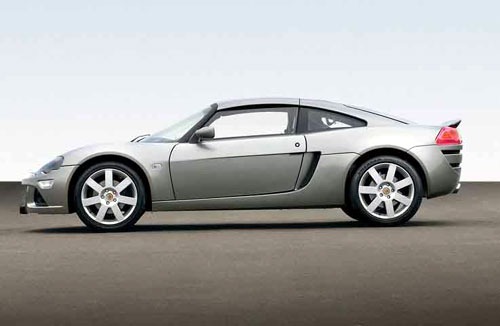




 Lotus Sport, the performance division of Lotus Cars Ltd., developed the Lotus Sport Exige 240R, a limited edition of 50 cars. With a supercharged and intercooled engine producing over 240 hp and over 170 lbft of torque, 0- 60mph in less than 4s and 100mph (160 km/h) in less than 10s before topping out at 155 mph (249 km/h). At this top speed the aerodynamics produce 113 kg of downforce increasing grip, stability and safety. More details
Lotus Sport, the performance division of Lotus Cars Ltd., developed the Lotus Sport Exige 240R, a limited edition of 50 cars. With a supercharged and intercooled engine producing over 240 hp and over 170 lbft of torque, 0- 60mph in less than 4s and 100mph (160 km/h) in less than 10s before topping out at 155 mph (249 km/h). At this top speed the aerodynamics produce 113 kg of downforce increasing grip, stability and safety. More details
 A prototype of the Lotus Sport Exige race car was unveiled at the annual FIA GT Championship presentation ceremony outside the world famous Casino in Monte Carlo, Monaco on 02 December, 2005. This car was designed for the FIA series to start in 2006 for race cars that have an equal power to weight, and that have a direct lineage to their road going versions. In its maiden year (2006), Lotus Cadena ran in the Avon Tyres British GT Championship. More
A prototype of the Lotus Sport Exige race car was unveiled at the annual FIA GT Championship presentation ceremony outside the world famous Casino in Monte Carlo, Monaco on 02 December, 2005. This car was designed for the FIA series to start in 2006 for race cars that have an equal power to weight, and that have a direct lineage to their road going versions. In its maiden year (2006), Lotus Cadena ran in the Avon Tyres British GT Championship. More 
 Lotus Cars has introduced the Exige 265E, which it describes as the most powerful road version of the car ever. The E suffix indicates that the Exige has been adapted to run on bio-ethanol. Lotus fitted a slightly modified version of the 2ZZ VVTL-i supercharged four-cylinder that powers the production Exige S. Running on E85, the car delivers 265 horsepower and sprints from zero to 60 mph in 3.9 seconds, with a top speed of 158 mph.
Lotus Cars has introduced the Exige 265E, which it describes as the most powerful road version of the car ever. The E suffix indicates that the Exige has been adapted to run on bio-ethanol. Lotus fitted a slightly modified version of the 2ZZ VVTL-i supercharged four-cylinder that powers the production Exige S. Running on E85, the car delivers 265 horsepower and sprints from zero to 60 mph in 3.9 seconds, with a top speed of 158 mph.
